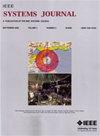Distributed Design of Joint Transmit and Receive Beamforming for MIMO Radar Networks Using Game Theory
IF 4.4
3区 计算机科学
Q1 COMPUTER SCIENCE, INFORMATION SYSTEMS
引用次数: 0
Abstract
This article investigates the problem of joint transmit and receive beamforming for a colocated multiple-input multiple-output radar network with multiple targets and signal-dependent interferences. At first, a distributed beamforming design scheme is developed using noncooperative game theory. The basis of this scheme is to minimize the maximum transmit power of antennas for each radar while adhering to the constraint of signal-to-interference-plus-noise ratio for the targets. By transforming the formulated optimization problem into a convex problem, the Lagrangian duality theory is utilized to decompose the original problem into two sub-problems. Then, a subgradient projection method and an equivalent receive beamforming optimization method are developed to tackle the two sub-problems, yielding the optimal transmit beamformers for the radars. After obtaining the transmit and receive beamformers iteratively, the game relationship among radars is then formulated as a power control game, and the paper proves the existence and uniqueness of the Nash equilibrium. Furthermore, a centralized beamforming design problem is explored for comparative analysis, where the beamformers of all radars are jointly optimized to suppress power fluctuations among transmit antennas. Simulation results are provided to validate the effectiveness of the proposed schemes.基于博弈论的MIMO雷达网络联合收发波束形成分布式设计
本文研究了具有多目标和信号相关干扰的多输入多输出雷达网络的联合发射和接收波束形成问题。首先,利用非合作博弈理论,提出了一种分布式波束形成设计方案。该方案的基础是在满足目标信噪比约束的前提下,使各雷达天线的最大发射功率最小。通过将公式化的优化问题转化为一个凸问题,利用拉格朗日对偶理论将原问题分解为两个子问题。针对这两个子问题,分别提出了亚梯度投影法和等效接收波束形成优化方法,得到了雷达的最优发射波束形成方案。在迭代得到发射和接收波束形成器后,将雷达间的博弈关系表示为功率控制博弈,并证明了纳什均衡的存在唯一性。在此基础上,探讨了集中波束形成设计问题,对所有雷达的波束形成进行联合优化,以抑制发射天线之间的功率波动。仿真结果验证了所提方案的有效性。
本文章由计算机程序翻译,如有差异,请以英文原文为准。
求助全文
约1分钟内获得全文
求助全文
来源期刊

IEEE Systems Journal
工程技术-电信学
CiteScore
9.80
自引率
6.80%
发文量
572
审稿时长
4.9 months
期刊介绍:
This publication provides a systems-level, focused forum for application-oriented manuscripts that address complex systems and system-of-systems of national and global significance. It intends to encourage and facilitate cooperation and interaction among IEEE Societies with systems-level and systems engineering interest, and to attract non-IEEE contributors and readers from around the globe. Our IEEE Systems Council job is to address issues in new ways that are not solvable in the domains of the existing IEEE or other societies or global organizations. These problems do not fit within traditional hierarchical boundaries. For example, disaster response such as that triggered by Hurricane Katrina, tsunamis, or current volcanic eruptions is not solvable by pure engineering solutions. We need to think about changing and enlarging the paradigm to include systems issues.
 求助内容:
求助内容: 应助结果提醒方式:
应助结果提醒方式:


